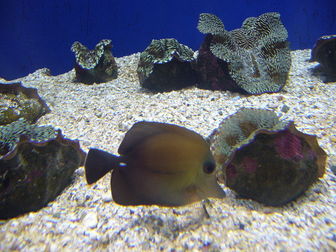Twotone tang
The Scopas Tang or Twotone Tang is a marine reef tang in the fish family Acanthuridae.

Original source: Own work Author Drow_male
Author: Drow_male
Permission: GNU Free Documentation License
The Twotone tang lives in the reef-associated, marine, depth range 1 - 60 m , usually 1 - 60 m environment.
Picture of a Twotone Tang, also called the Brown Sailfin Tang or Scopas Tang, Zebrasoma scopas * Puzzles * Postcards Zebrasoma scopas Photo © Animal-World: Courtesy David BroughLatest Reader Comment - See MoreVery beautiful fish - the picture doesn't do More
The Twotone Tang is known for it’s grazing abilities and will eat not only filamentous algae but also Valonia and Bryopsis. More
Twotone tang, Sailfin tang and other. More
Twotone tang, Sailfin tang and other. Add this fish pack into your aquarium and get more Aquarium Fun! Screen Savers - Nature & Scenery, On July 3, 2007 updated, downloaded 30 times, file size is 6688Kb. More
This fish is known as Twotone Tang and the correct latin name is Zebrasoma Scopas. It belongs to the Tang family. (e) It's origin is Indo-Pacific. (e) Character and suggestions regarding care This fish is peaceful. More
such well-known aquarium fish as Yellow tang, Twotone tang, Sailfin tang and other species of fish among the aquarium fish, constituting Zebrasoma fish pack. More
the common name Twotone tang alludes to the colouration of the juvenile fish. The adult fish has an oval bristle-like patch (the setae) right in front of its peduncular spine which is not developed until the fish reaches a length of 7 cm / 2.8 in. More
Common names
Acanthure à pierreries in French (français)
Ædelstens-kirurgfisk in Danish (dansk)
Baltadyglė chirurgžuvė in Lithuanian (lietuvių kalba)
Bit in English
Bit in Kumak
Blue-lined tang in English
Bluelined sailfin tang in English
Bobona in Gela
Bodlok žlutý in Czech (česky)
Bouc in Creole, French
Bouc in Creoles and Pidgins, French
Brown saiffin tang in English
Brown sailfin surgeonfish in English
Brown sailfish surgeonfish in English
Brown sailing tang in English
Brown tang in English
Brushtail tang in English
Burung laut in Malay (bahasa Melayu)
Cà Đuôi gai nâu hồng in Vietnamese (Tiếng Việt)
Cà Ðuôi gai nâu h?ng in Vietnamese (Tiếng Việt)
Cà Ðuôi gai nâu hong in Vietnamese (Tiếng Việt)
Canivete bicolor in Portuguese (Português)
Canivete manchaco in Portuguese (Português)
Chirurgien à balai in French (français)
Chirurgien à brosses in French (français)
Chirurgien à robe sombre in French (français)
Chirurgien brun in French (français)
Chirurgien jaune in French (français)
Debam in Malay (bahasa Melayu)
Dengkis in Malay (bahasa Melayu)
Fam Fol in Creole, French
Fam Fol in Creoles and Pidgins, French
Gem surgeonfish in English
Gespikkelde tang in Afrikaans
Gomahagi in Japanese (日本語)
Hugupau chokolati in Austronesian (Other)
Hugupau chokolati in Carolinian
Keltavälskäri in Finnish (suomen kieli)
Lemon sailfin in English
Ligapwarig in Austronesian (Other)
Ligapwarig in Carolinian
Mokoraa in Rapa
Mokoraa in Rapanui
Pe'ape'a in Samoan (gagana fa'a Samoa)
Peretiti in Tahitian (Reo Mā`ohi)
Peretti in Tahitian (Reo Mā`ohi)
Pitopito in Samoan (gagana fa'a Samoa)
Røgfarvet kirurgfisk in Danish (dansk)
Ruskovälskäri in Finnish (suomen kieli)
Sárga doktorhal in Hungarian (Magyar)
Spotted tang in English
Tabac in Creole, French
Tabac in Creoles and Pidgins, French
Tweekleur-tang in Afrikaans
Two-tone surgeonfish in English
Twotone tang in English
Via in Fijian (vosa Vakaviti)
Weißdorn-Segelflossendoktor in German (Deutsch)
Yellow sailfin tang in English
Yellow tang in English
Zebrasoma flavescens in Polish (polski)
三角倒吊 in Mandarin Chinese
宝石高鳍刺尾鱼 in Mandarin Chinese
寶石高鰭刺尾魚 in Mandarin Chinese
小高鰭刺尾魚 in Mandarin Chinese
小高鳍刺尾鱼 in Mandarin Chinese


Original source: FishBase
Permission: Some rights reserved
Family : Acanthuridae
Genus : Zebrasoma
Species : Zebrasoma scopas
Authority : Cuvier, 1829
